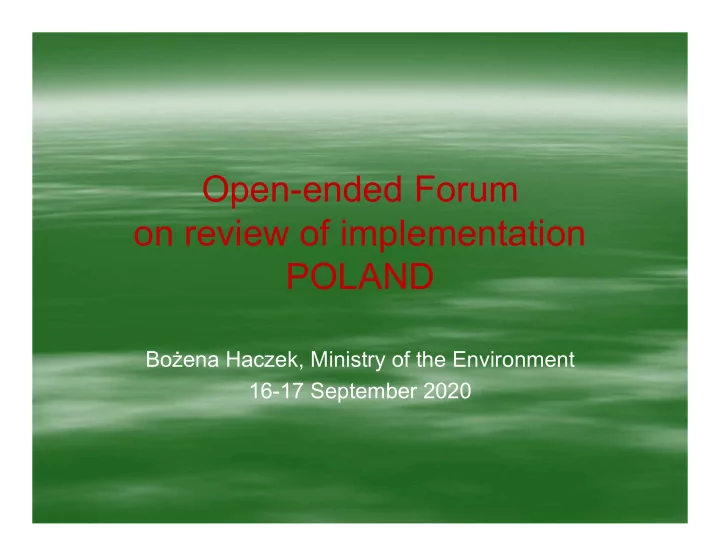

Open-ended Forum on review of implementation POLAND Bożena Haczek, Ministry of the Environment 16-17 September 2020
6 National Report Drafted by the Ministry of the Environment in consultation with other sectors and relevant stakeholders Adopted by the Minister of the Environment Submitted to the SCBD on 14 February 2019 Available on the CHM (on-line)
NBSAP Drafted by a group of experts in the MoE, consulted at national level with other sectors and interested actors and stakeholders Adopted by the Council of Ministers in November 2015 Transforms into national level obligations of the global Strategic Plan for Biodiversity 2011-2020 and the EU Biodiversity Strategy One overarching goal, seven objectives, several dozen of targets with rationale, leading actors and indicators
NBSAP objectives Improvement of knowledge level and increase society activities Improvement of nature protection system Preservation and restoration of natural habitats and endangered species Maintenance and reconstruction of ecosystems providing services for humans Integration of economy sectors with biodiverisity objectives Reducing threats from climate change and IAS Increasing PL participation on biodiversity in international fora
Improvement of knowledge level and increase of society activities Development of nature inventory database and methodology of data collection Extension and update of the Central Register of Nature Protection Forms Development of additional subsystems of nature monitoring Trainings for public administration and enforcement authorities on legal regulations Development of biodiversity protection volunteering system Development of local partnerships Implementation of educational programmes and biodiversity campaigns
Improvement of nature protection system Enlargement of national parks and nature reserves network Improving nature protection in landscape parks and protected landscape areas Development of management plans for protected areas and incorporation of their indications into sectoral documents and local law Establishment and implementatiom of protection activities monitoring system Review of methodologies on state of nature habitats and species Increase of effectiveness of absorption of biodiversity funds
Preservation and restoration of natural habitats and endangered species Development and implementation of national protection programmes for key protected species Determination of distribution of breeding birds species Organization of rescue centers for protected, alien and dangerous animal species Development and implementation of protection and restoration projects on degraded habitats
Maintenance and reconstruction of ecosystems providing services for humans Identification and assessment of the state of ecosystem functions/services Inclusion of green infrastructure into spatial planning at the local level
Agriculture and forestry Promotion of rational management of native breeds of farm animals Collection and storage of farm animals biological material in the National Gene Bank Protection of forest birds, rare native tree species and increase in volume of dead wood in forests Increase water retention in forests Formation and maintenance of forest stands of diverse structure and age
Fishery Implementation of regulation on reduction of discards in fishery Development and implementation of data recording procedures on by-catch of protected species Identification and implementation of fishing techniques and tools fostering biodiversity protection Conservation of endagered species habitats by maintenance or recovery of extensive fisheries management of fishponds
Water management and tourism Development and implementation of guidelines on biodiversity protection in hydrotechnical investments Implementation of instruments to maintain natural habitats of endangered migrating fish species Development and promotion of principles for sustainable tourism development in areas of high biodiversity values Enhance of integration of tourist activities for nature protection
Reducing threats from climate change and alien species Development of appropriate organizational and financial arrangements for implementation of the EU regulation on IAS Implementation of alien species eradication programmes Establishment of supervision and monitoring system of invasive alien species
Increasing PL participation on biodiversity in international fora Cooperation on protection and management of protected species and habitats in transboundary and biogeographical regions Implementation of ABS regulations Supporting research and biodiversity protection activities outside PL borders Implementation of exotic timber trade regulations
Technical and financial resources System of nature conservation bodies: - Minister of the Environment - General Directorate for Environmental Protection and 16 regional directorates - 16 voivods and 16 marshalls - 23 directors of national parks - 380 district starostes and app. 2500 mayors Advisory bodies: - The State Council for Nature Protection - 16 regional councils for nature protection - Scientific councils in national and landscape parks
Technical and financial resources Biodiversity monitoring and checks of users of genetic resources – Chief Inspectorate of Environmental Protection and 16 regional inspectors Financial sources: - National Fund for Environmental Protection and Water Management and 16 regional funds - EU financial programmes, European Economic Area and Norway Grants and Swiss Fund Money spent on biodiversity: 354 mln USD/year
Need for adjustment of NBSAP The current NBSAP developed in 2014-2015 Need to revise and update NBSAP accordingly to current priorities New NBSAP will be based on post 2020-GBF and new EU biodiversity strategy, taking into account national conditions and circumstances
Unresolved challenges Several targets in current NBSAP will probably not be reached by the end of 2020 Main reasons: - insufficient human and financial resources - not sufficient promotion of biodiversity issues within the whole society - not sufficient cooperation between stakeholders
Recommend
More recommend